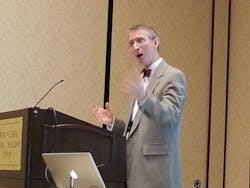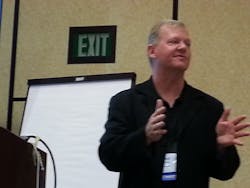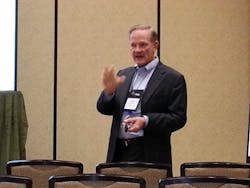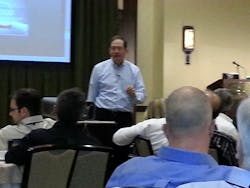Logistics Pros Connect to Generate Competitive Power
You might expect an executive summit dedicated to innovation—and put on by an association of material handling equipment and system manufacturers—would be all about the wonders of their automation. In the case of MHI’s 2014 annual conference, you’d be wrong. The presenters at this week’s gathering of technology suppliers at San Diego’s Rancho Bernardo Inn made a strong case for building innovative relationships with their customers. Just so there’s no confusion, that’s you.
In his session on Demystifying Supply Chain Innovation, Jim Rice, from the MIT Center for Transportation and Logistics, offered examples of how suppliers have made a huge impact on innovation in their customers’ organizations. One example went as far back as the 70s and 80s, when Chrysler worked with its suppliers to invent a model of collaboration. Then in the CPG industry P&G introduced continuous replenishment. Unfortunately, those examples didn’t cause a multi-industry revolution.
“Many organizations aren’t sharing data because of a lack of trust,” Rice said. “Even within an industry it’s difficult to achieve. All of these cyber-attacks have exposed vulnerabilities which will stunt use of the cloud. Many companies don’t even want to let their insurance companies know what they’re experiencing, even though it might make their overall system better.”
In their keynote presentation on “Game-changing innovation that is revolutionizing manufacturing,” Ronald Clapman, senior account executive at T-Sciences, and Michael Walton, head of manufacturing at Google Enterprise, showed where technological cooperation is alive and well: and it’s between technology and its users.
“The fusion of the digital and physical—digical—came out in Harvard Business Review,” Clapman noted (while wearing google glass). “It’s not that we don’t have the data, it’s that we don’t know what to do with all of it. We’ve lost the human touch. We can bring that back with mobile devices. The problem is we’ve created silos in information technology. It’s hard to build cooperation into those silos. What ties them all together is a coordinate. There is a ‘where’ associated with assets. By leveraging spatial information you tie all of it together. We’re looking out into the third dimension—seamless integration between the outside and inside worlds. When a truck arrives the product goes right into the factory.”
Mike Walton said the human touch is still important, even where robots are concerned.
“Two years ago google went on a buying spree of robotics companies,” he noted. “The most advanced, google now produces. They can do pattern recognition, breaking down patterns to the lowest square inch. These FoxBots will be working side by side with humans to produce the iPhone 6. Making things faster, better and more efficient by leveraging humans assisted by mechanical devices. A robot that’s geo smart, that learns from humans, gives a lot more time back to manufacturing so humans can be used smarter rather than at a commodity level.”
John Kao, chairman of the Institute for Large Scale Innovation, and CEO and founder of EdgeMakers, equated such innovation to jazz music in his luncheon presentation. And he used a concert piano to show how innovative choices surrounding a theme can be applied in business.
“Innovation is a practice,” he said. “Thelonious Monk said you need to play a song you like 500 times a day. That leads to a shift in perception of your underlying task. It helps you see more deeply into what you’re doing. Innovation is collaborative learning. It requires exposing yourself to the possibility that you don’t know what you’re doing. Jazz musicians learn by getting their rear ends kicked in competition and then going home and figuring it all out. If you don’t expose yourself through practice in a social environment you won’t learn. Get feedback so you can iterate rapidly. The only advantage America has in that regard is our ability to forgive failure. That’s why young talent comes here. China has pushed $500 billion onto this poker table called innovation. That’s why there are more graduate students studying design in China than anywhere else in the world.”
But innovation in one population is old school in another—even within an industry. Dwight Klappich, analyst with Gartner, an information technology research and advisory firm, noted that manufacturing is 20 years ahead of warehousing in data farming.
“Warehouse systems are pretty dumb,” he said. “If you went up to a manufacturing research person and told them how cool wave planning is, they’d probably laugh at you. There’s much more sophisticated use of constraint based planning and optimization technology in manufacturing and we’re now starting to see [logistics execution] vendors say we need to be applying those techniques, having systems do more robust planning, looking across all of the work, starting at loading the truck and building the schedule to that. We don’t have that in warehousing.”
If you use these systems, though, don’t expect perfection. In fact if things appear perfect, something’s wrong, said Joel Sutherland, managing director at the University of San Diego. In his address on “Creating a Superior Supply Chain through Innovation,” he stressed the importance of breaking the “communication by silo” model for innovation to be legitimate.
“Collect ideas from throughout the organization,” he advised. “If you don’t ask, they won’t share their thoughts. Those companies that are innovative for more than five years have a compounded growth rate of 84% vs. those that don’t and have one that’s closer to 28%.
And harkening back to the theme of collaboration through cooperation, Sutherland told the story of JustBorn, manufacturer of those little yellow marshmallow peeps that come out at Easter time. This confection company was paying a lot for dead space in the trucks carrying its peeps to market. So they engaged Lehigh University to help solve the problem.
“Then they collaborated with other confection companies in the same boat but don’t directly compete with them,” Sutherland said. “They deliver to the same companies, co-loading their freight. Trust is a big challenge [in relationships like this] as is sharing savings. This ‘Confection Connection’ increased the delivery frequency to their customers to daily and reduced freight expense at least 25% and in some cases 40%. Their collaboration was innovative and helped them compete with the big boys.”
Economist Jason Schenker, president of Prestige Economics, used his general session presentation to show the automation suppliers in his audience—which serve all companies big and small—that what they do can make a big difference to those companies. All they have to do is read the economic tea leaves.
“Short term, capital costs and raw materials costs will rise slightly and labor costs will rise in certain regions,” he said. “Which manufacturing sectors are best prepared? It depends on how good their risk management is. Those are usually the companies with the best planning structure.”
Will rising labor costs in China be good for the people in his audience?
“It will bring some jobs back to the U.S.,” Schenker answered. “It will also bleed jobs into lower cost places. That’s a race to Africa. But there’s also automation to factor in. A manufacturer can go to where the labor is cheaper and stay a couple decades—then move again—or they can automate. They’re running out of countries where they’ll get that huge labor cut.”
To close the loop on the power of innovation, Jeff Gallinat, senior vice president of supply chain operations for Cisco, concluded that it’s all about developing a talent for connecting the dots.
“That requires different skills than what we’ve seen,” he said. “This is where data scientists and data managers come in. At Georgia Tech no one is doing physical industrial engineering anymore. They don’t care about optimizing islands of automation anymore. The best IE schools are figuring out how to best horizontally manage process, people, rules and information.”
Gallinat explained how his organization consolidated its warehousing into multi node distribution centers because it’s too expensive to produce special-purpose items. This effort resulted in a closer connection to its own operations and to its partners.
“We built a partitioned public cloud to connect everyone with the same information,” he explained. “I can instantly see the supply status of every point in the network. That’s a three year several million dollar investment. Of all the things we do from a customer experience point of view as a hardware manufacturer, the number one opportunity we have is to substantially change the perception of our company based on the delivery experience.”
Conclusion: the power of innovation today lies in logistics.
About the Author
Tom Andel Blog
former Editor-in-Chief
As editor-in-chief from 2010-2014, Tom Andel oversaw the strategic development of MH&L and MHLnews.com, bringing 30+ years of thought leadership and award winning coverage of supply chain, manufacturing logistics and material handling. Throughout his career he also served in various editorial capacities at other industry titles, including Transportation & Distribution, Material Handling Engineering, Material Handling Management (predecessors to MH&L), as well as Logistics Management and Modern Materials Handling. Andel is a three-time finalist in the Jesse H. Neal Business Journalism Awards, the most respected editorial award in B2B trade publishing, and a graduate of Cleveland’s Case Western Reserve University.








